Influence of Ethanol Blended Diesel Enriched with Hydroxy Gas in Dual-Fuel Mode on Common Rail Direct Injection Engine
Abstract
:1. Introduction
2. Materials and Methods
3. Experimental Procedure
Uncertainty Interpretation
4. Result and Discussion
4.1. Brake Thermal Efficiency
4.2. Brake-Specific Energy Consumption
4.3. Oxides of Nitrogen Emission (NOx)
4.4. Carbon Monoxide Emission (CO)
4.5. Hydrocarbon Emission (HC)
4.6. Smoke Emission
4.7. Exhaust Gas Temperature
4.8. Cylinder Pressure
4.9. Heat Release Rate (HRR)
5. Conclusions
- The SS316L plate-type dry cell electrolyser has been demonstrated as an effective device for producing HHO gas by on-board technique from a 20 g/L NaOH electrolytic catalyst solution.
- The incorporation of HHO gas led to noteworthy increases in both cylinder pressure and HRR values when compared to their respective counterparts. Under maximum BMEP conditions, the thermal brake efficiency experienced a notable enhancement of 2.74%. This was achieved using a 20% ethanol blend in conjunction with a consistent flow rate of 2 LPM of HHO gas, as compared to using only the 20% ethanol blend. Furthermore, there was a simultaneous decrease of 5.89% in Brake Specific Energy Consumption (BSEC), reducing it from 9245 to 8900 kJ/kW-h.
- At the peak BMEP condition, substantial reductions of 4.61%, 5.19%, and 3.1% were achieved in engine exhaust emissions, namely HC, CO, and smoke, through the utilization of E20 + 2 LPM HHO.
- The NOx emissions and EGT increased by 3.22% and 3.06% for E20 + 2 LPM compared to E20 at maximum BMEP condition.
- HHO gas induction demonstrated a successful way of enhancing performance and lowering diesel engine emissions. When combined with lower ethanol blends, this impact helped to reduce emission values further, and the experimental results indicate that adding 2 LPM of HHO gas to a 20% volume of ethanol-diesel blend improves engine performance, combustion, and emission characteristics.
- Future research will focus on optimizing electrolyser variables for efficient HHO gas production using plate-type dry cell electrolysers and optimizing engine process parameters for efficient dual-fuel operation with different combustion bowl geometries using machine learning techniques.
Author Contributions
Funding
Data Availability Statement
Conflicts of Interest
Abbreviations
| BMEP | Brake Mean Effective Pressure (bar) |
| BSEC | Brake Specific Energy Consumption (kJ/kW-h) |
| BTE | Brake Thermal Efficiency (%) |
| CFM | Cubic Feet Per Minute |
| CO2 | Carbon dioxide |
| CO | Carbon monoxide (g/kW-h) |
| CP | Cylinder Pressure (bar) |
| CRDI | Common Rail Direct Injection |
| CI | Compression-Ignition |
| DC | Direct current |
| EGT | Exhaust Gas Temperature (°C) |
| E20 | Ethanol 20% with 80% of Neat Diesel |
| HC | Hydrocarbons (g/kW-h) |
| HHO | Hydroxy |
| HRR | Heat Release Rate (J/deg) |
| I.C. | Internal Combustion |
| LPM | Litre per minute |
| ND | Neat Diesel |
| NOx | Nitrogen oxides (g/kW-h) |
References
- The Outlook for Energy. A View to 2040. 2017. Available online: https://cdn.exxonmobil.com/media/global/files/outlook-for-energy/2017/2017-outlook-for-energy.pdf (accessed on 15 August 2019).
- Indian Natural Gas Petroleum & Natural Gas Statistics 2017–2018. 2019. Available online: https://petroleum.nic.in/more/Indi-an-png-statistics (accessed on 28 July 2019).
- Environmental Performance Index (EPI) 2018. Available online: https://www.google.com.hk/url?sa=i&rct=j&q=&esrc=s&source=web&cd=&cad=rja&uact=8&ved=0CAIQw7AJahcKEwjYwcvl_oiBAxUAAAAAHQAAAAAQAg&url=https%3A%2F%2Fepi.yale.edu%2Fdownloads%2Fepi2018policymakerssummaryv01.pdf&psig=AOvVaw3vNgFBT8zNdP0MobOfFlTW&ust=1693643179091482&opi=89978449 (accessed on 25 July 2019).
- Viswanathan, K.; Taipabu, M.I.; Wu, W. Novel Petit grain bitter orange waste peel oil biofuel investigation in diesel engine with modified fuel injection pressure and bowl geometry. Fuel 2022, 319, 123660. [Google Scholar] [CrossRef]
- Ganesan, N.; Viswanathan, K.; Karthic, S.; Ekambaram, P.; Wu, W.; Vo, D.-V.N. Split injection strategies based RCCI combustion analysis with waste cooking oil biofuel and methanol in an open ECU assisted CRDI engine. Fuel 2022, 319, 123710. [Google Scholar] [CrossRef]
- Viswanathan, K.; Paulraj, A. A comprehensive study on the performance and emission characteristics of a diesel engine with the blends of diesel, jojoba oil biodiesel, and butylated hydroxyl anisole as an alternative fuel. Energy Sources Part A Recovery Util. Environ. Eff. 2023, 45, 3216–3230. [Google Scholar] [CrossRef]
- Madhujit, D.; Abhishek, P.; Durbadal, D.; Sastry, G.R.K.; Panua, R.S.; Bose, P.K. An experimental investigation of performance-emission trade of characteristics of a CI engine using hydrogen as dual fuel. Energy 2015, 85, 569–585. [Google Scholar] [CrossRef]
- Yilmaz, A.C.; Uludamar, E.; Aydin, K. Effect of hydroxy (HHO) gas addition on performance and exhaust emissions in compression ignition engines. Int. J. Hydrogen Energy 2010, 35, 11366–11372. [Google Scholar] [CrossRef]
- Matienzo, J.M.R. Influence of addition of hydrogen produced on board in the performance of a stationary diesel engine. Int. J. Hydrogen Energy 2018, 43, 17889–17897. [Google Scholar] [CrossRef]
- Aydin, K.; Kenanoğlu, R. Effects of hydrogenation of fossil fuels with hydrogen and hydroxy gas on performance and emissions of internal combustion engines. Int. J. Hydrogen Energy 2018, 43, 14047–14058. [Google Scholar] [CrossRef]
- Ismail, T.M.; Ramzy, K.; Abelwhab, M.N.; Elnaghi, B.E.; Abd El-Salam, M.; Ismail, M.I. Performance of hybrid compression ignition engine using hydroxy (HHO) from dry cell. Energy Convers. Manag. 2018, 155, 287–300. [Google Scholar] [CrossRef]
- Masjuki, H.; Ruhul, A.; Mustafi, N.N.; Kalam, M.; Arbab, M.; Fattah, I.R. Study of production optimization and effect of hydroxyl gas on a CI engine performance and emission fueled with biodiesel blends. Int. J. Hydrogen Energy 2016, 41, 14519–14528. [Google Scholar] [CrossRef]
- Uludamar, E. Effect of hydroxy and hydrogen gas addition on diesel engine fuelled with microalgae biodiesel. Int. J. Hydrogen Energy 2018, 43, 18028–18036. [Google Scholar] [CrossRef]
- Baltacioglu, M.K.; Arat, H.T.; Özcanli, M.; Aydin, K. Experimental comparison of pure hydrogen and HHO (hydroxy) enriched biodiesel (B10) fuel in a commercial diesel engine. Int. J. Hydrogen Energy 2016, 41, 8347–8353. [Google Scholar] [CrossRef]
- Thiyagarajan, S.; Varuvel, E.; Karthickeyan, V.; Sonthalia, A.; Kumar, G.; Saravanan, C.; Dhinesh, B.; Pugazhendhi, A. Effect of hydrogen on compression-ignition (CI) engine fueled with vegetable oil/biodiesel from various feedstocks: A review. Int. J. Hydrogen Energy 2022, 47, 37648–37667. [Google Scholar] [CrossRef]
- Yilmaz, N.; Vigil, F.M.; Donaldson, A.B.; Darabseh, T. Investigation of CI engine emissions in biodiesel–ethanol–diesel blends as a function of ethanol concentration. Fuel 2014, 115, 790–793. [Google Scholar] [CrossRef]
- Parthasarathy, M.; Lalvani, J.I.J.; Dhinesh, B.; Annamalai, K. Effect of hydrogen on ethanol–biodiesel blend on performance and emission characteristics of a direct injection diesel engine. Ecotoxicol. Environ. Saf. 2016, 134, 433–439. [Google Scholar] [CrossRef]
- Prakash, T.; Geo, V.E.; Martin, L.J.; Nagalingam, B. Effect of ternary blends of bio-ethanol, diesel and castor oil on performance, emission and combustion in a CI engine. Renew. Energy 2018, 122, 301–309. [Google Scholar] [CrossRef]
- Taipabu, M.I.; Viswanathan, K.; Wu, W. Process design and optimization of green processes for the production of hydrogen and urea from glycerol. Int. J. Hydrogen Energy 2023, 48, 24212–24241. [Google Scholar] [CrossRef]
- Nabil, T.; Khairat Dawood, M.M. Enabling efficient use of oxy-hydrogen gas (HHO) in selected engineering applications; transportation and sustainable power generation. J. Clean. Prod. 2019, 237, 117798. [Google Scholar] [CrossRef]
- Hansen, A.C.; Zhang, Q.; Lyne, P.W. Ethanol–diesel fuel blends––A review. Bioresour. Technol. 2004, 96, 277–285. [Google Scholar] [CrossRef] [PubMed]
- Huang, Y.; Hong, G.; Huang, R. Numerical investigation to the dual-fuel spray combustion process in an ethanol direct injection plus gasoline port injection (EDI + GPI) engine. Energy Convers. Manag. 2015, 92, 275–286. [Google Scholar] [CrossRef]
- Mazloomi, K.; Gomes, C. Hydrogen as an energy carrier: Prospects and challenges. Renew. Sustain. Energy Rev. 2012, 16, 3024–3033. [Google Scholar] [CrossRef]
- Boretti, A. Advances in hydrogen compression ignition internal combustion engines. Int. J. Hydrogen Energy 2011, 36, 12601–12606. [Google Scholar] [CrossRef]
- Madhankumar, S.; Viswanathan, K.; Wu, W. Energy, exergy and environmental impact analysis on the novel indirect solar dryer with fins inserted phase change material. Renew. Energy 2021, 176, 280–294. [Google Scholar] [CrossRef]
- Madhankumar, S.; Viswanathan, K. Computational and experimental study of a novel corrugated-type absorber plate solar collector with thermal energy storage moisture removal device. Appl. Energy 2022, 324, 119746. [Google Scholar] [CrossRef]
- Madhankumar, S.; Viswanathan, K.; Wu, W.; Taipabu, M.I. Analysis of indirect solar dryer with PCM energy storage material: Energy, economic, drying and optimization. Sol. Energy 2023, 249, 667–683. [Google Scholar] [CrossRef]
- Abdelaal, H.; Sadik, M.; Bassyouni, M.; Shalabi, M. A new approach to utilize Hydrogen as a safe fuel. Int. J. Hydrogen Energy 2005, 30, 1511–1514. [Google Scholar] [CrossRef]
- Geng, L.; Bi, L.; Li, Q.; Chen, H.; Xie, Y. Experimental study on spray characteristics, combustion stability, and emission performance of a CRDI diesel engine operated with biodiesel–ethanol blends. Energy Rep. 2021, 7, 904–915. [Google Scholar] [CrossRef]
- Verhelst, S.; Wallner, T. Hydrogen-fueled internal combustion engines. Prog. Energy Combust. Sci. 2009, 35, 490–527. [Google Scholar] [CrossRef]
- Samuel Panithasan, M.; Venkadesan, G. Evaluation of the Influence of 1, 4-Dioxane and Exhaust Gas Recirculation on the Performance and Emission Values of a Diesel Engine Fuelled with Low Viscous Biofuel Blend. In Proceedings of the ASME 2021 15th International Conference on Energy Sustainability Collocated with the ASME 2021 Heat Transfer Summer Conference, Virtual, 16–18 June 2021. ASME Digital Collection. [Google Scholar]
- Sharma, P.K.; Sharma, D.; Soni, S.L.; Jhalani, A.; Singh, D.; Sharma, S. Energy, exergy, and emission analysis of a hydroxyl fueled compression ignition engine under dual fuel mode. Fuel 2020, 265, 116923. [Google Scholar] [CrossRef]
- Gnanamoorthi, V.; Vimalananth, V. Effect of hydrogen fuel at higher flow rate under dual fuel mode in CRDI diesel engine. Int. J. Hydrogen Energy 2020, 45, 16874–16889. [Google Scholar] [CrossRef]
- Panithasan, M.S.; Gopalakichenin, D.; Venkadesan, G.; Malairajan, M. Evaluating the working characters of a diesel engine fueled with biodiesel blends added with rice husk Nano particles. Energy Sources Part A Recover. Util. Environ. Eff. 2020, 1–19. [Google Scholar] [CrossRef]
- Jeyaseelan, T.; Chacko, N.; Pushyanth, N.; Alexander, J.; Porpatham, E. Partial hydrogenation and hydrogen induction: A comparative study with B20 operation in a turbocharged CRDI diesel engine. Int. J. Hydrogen Energy 2021, 46, 22659–22669. [Google Scholar] [CrossRef]
- Reşitoğlu, İ.A.; Altinişik, K.; Keskin, A. The pollutant emissions from diesel-engine vehicles and exhaust aftertreatment systems. Clean Technol. Environ. Policy 2015, 17, 15–27. [Google Scholar] [CrossRef]
- Sandalci, T.; Karagöz, Y. Experimental investigation of the combustion characteristics, emissions and performance of hydrogen port fuel injection in a diesel engine. Int. J. Hydrogen Energy 2014, 39, 18480–18489. [Google Scholar] [CrossRef]
- Rimkus, A.; Matijošius, J.; Bogdevičius, M.; Bereczky, Á.; Török, Á. An investigation of the efficiency of using O2 and H2 (hydrooxile gas-HHO) gas additives in a CI engine operating on diesel fuel and biodiesel. Energy 2018, 152, 640–651. [Google Scholar] [CrossRef]
- Li, G.; Long, Y.; Zhang, Z.; Liang, J.; Zhang, X.; Zhang, X.; Wang, Z. Performance and emissions characteristics of a lean-burn marine natural gas engine with the addition of hydrogen-rich reformate. Int. J. Hydrogen Energy 2019, 44, 31544–31556. [Google Scholar] [CrossRef]
- Zhao, B.; Wang, H.; Liao, Y.; Nasif, O.; Alharbi, S.A.; Shanmugam, S.; Chi, N.T.L.; Shanmuganathan, R. Effects of hydrocarbon liquid and HHO as the alternate fuel for unmodified compression ignition engines. Fuel 2022, 324, 124726. [Google Scholar] [CrossRef]

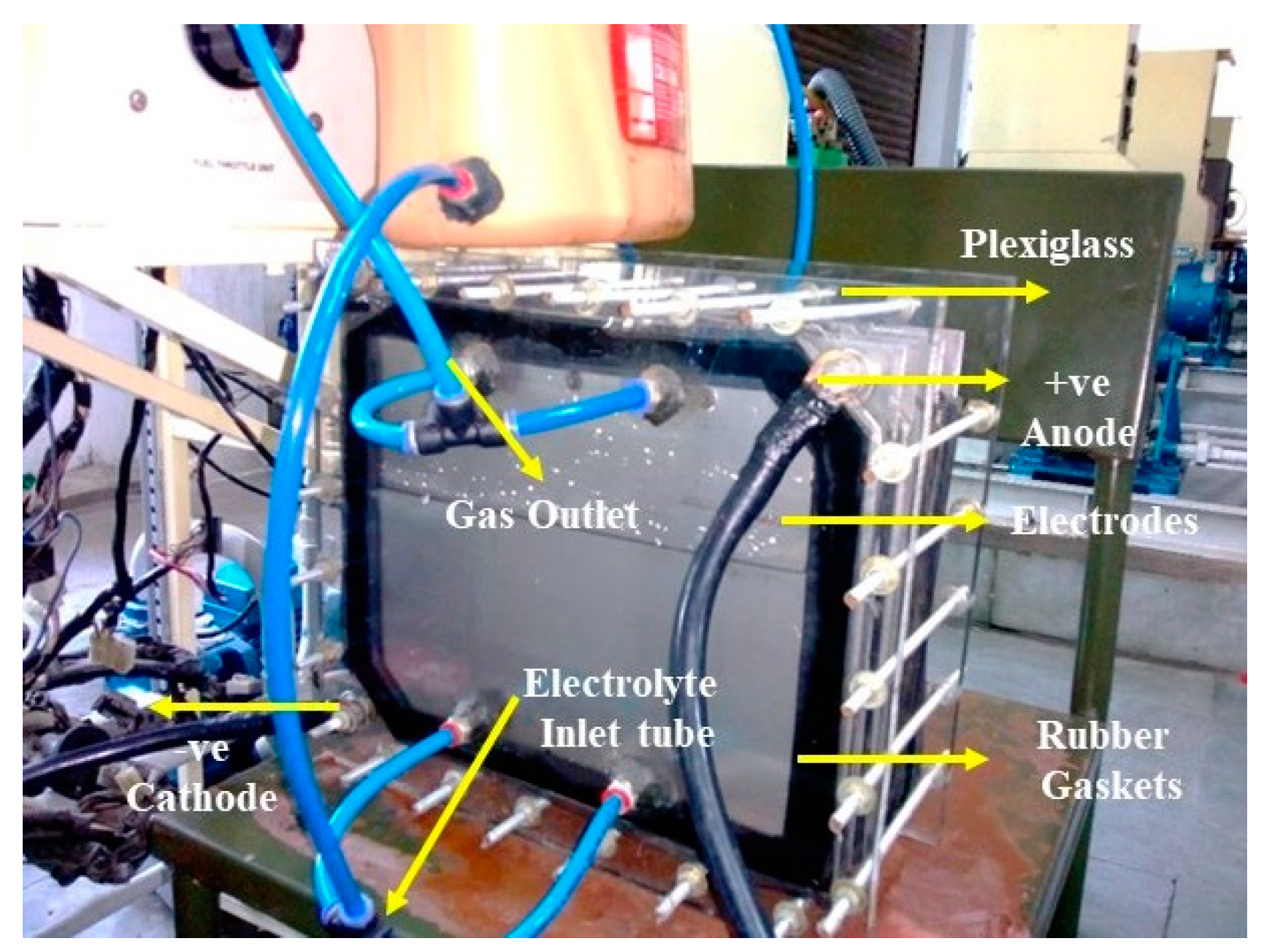
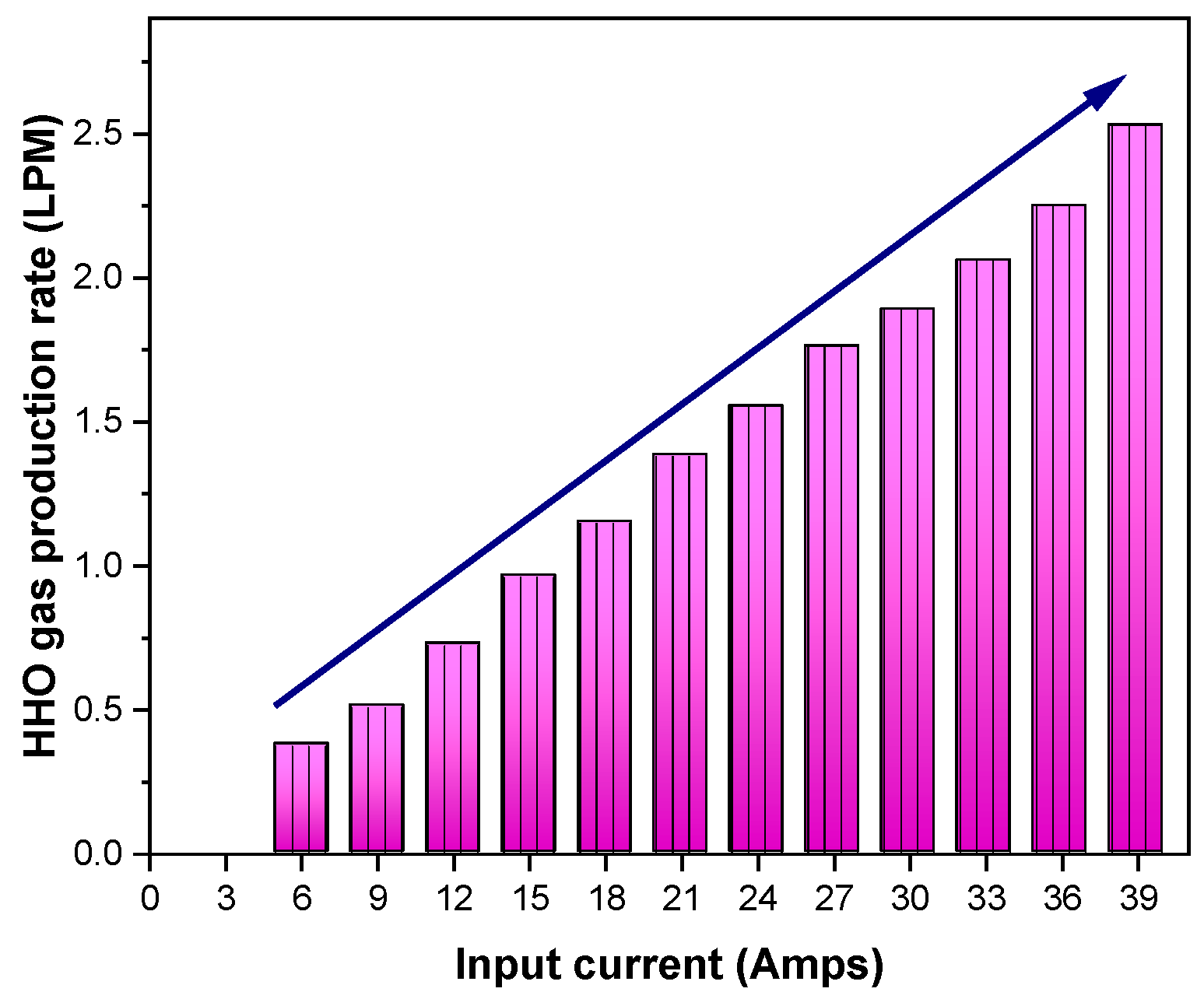



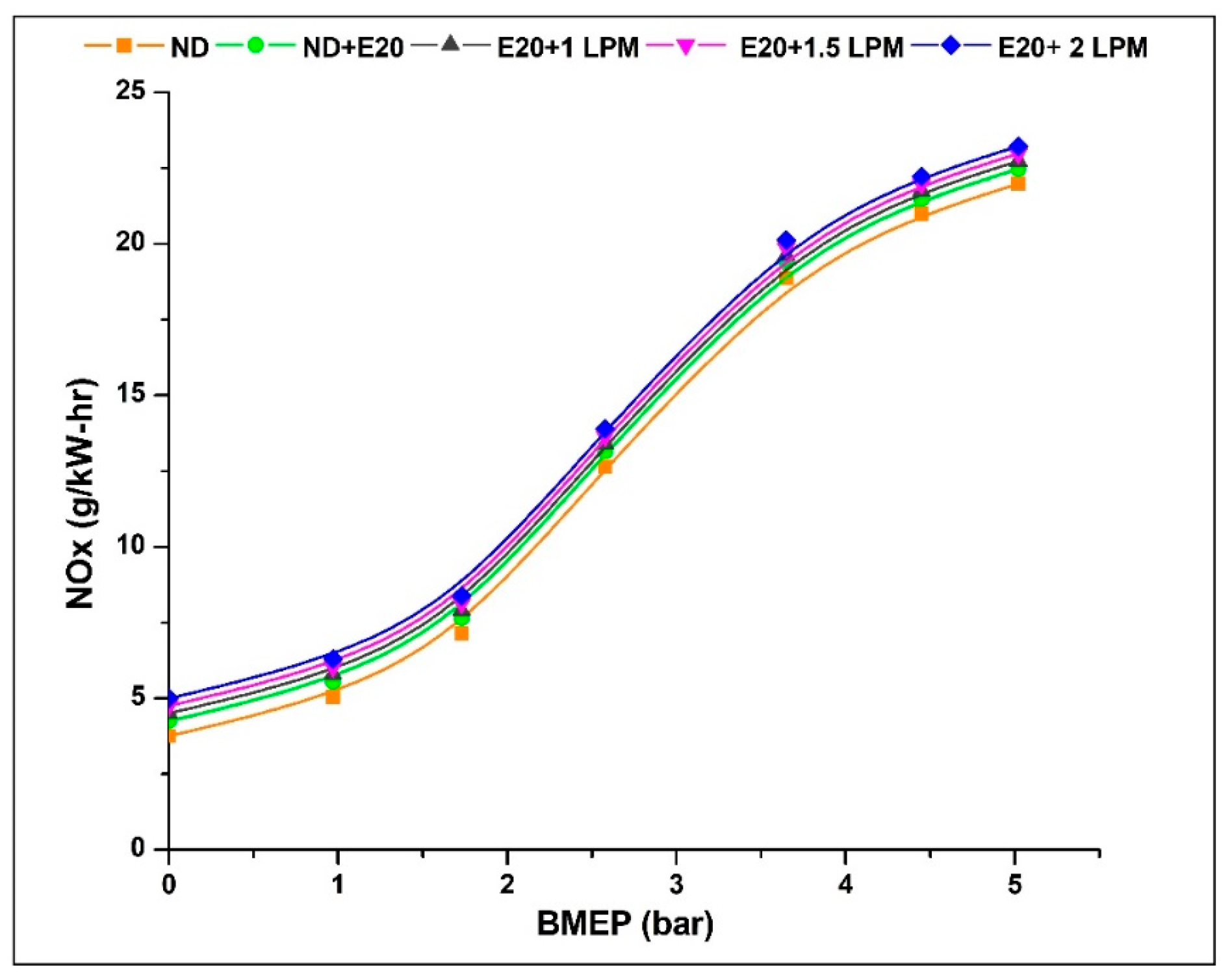
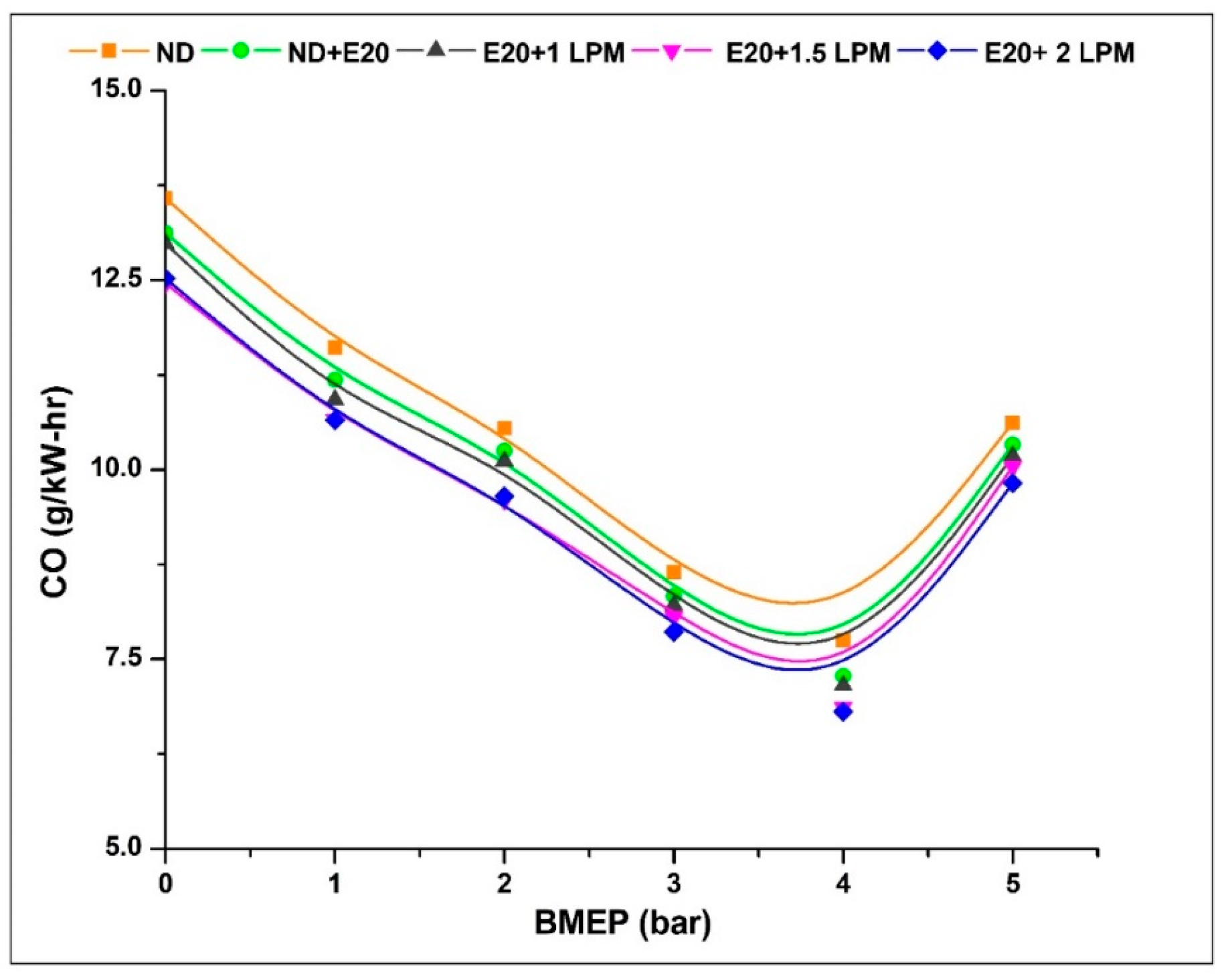
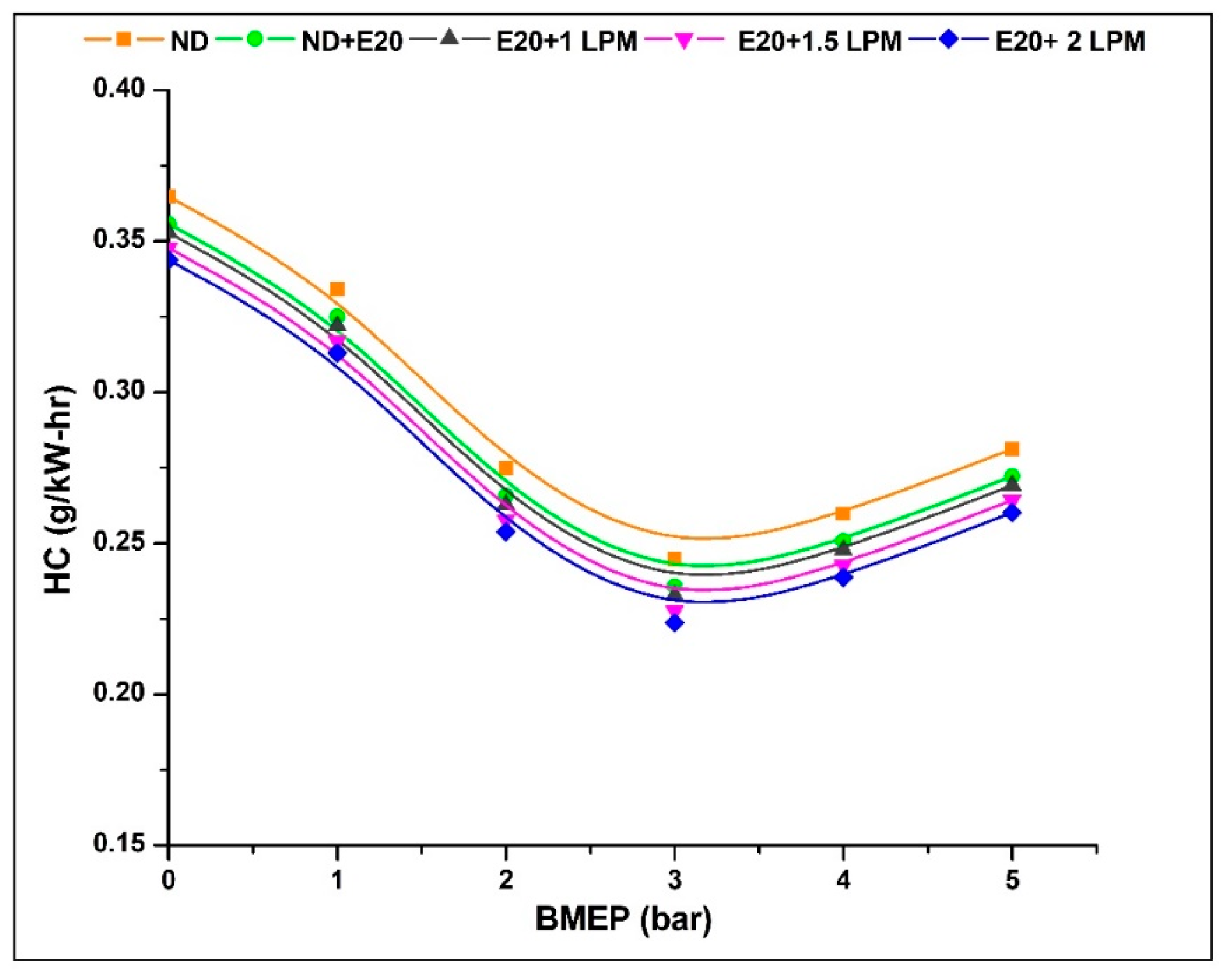




| Parameters | Values |
|---|---|
| Plate sizes (mm) | 150 × 150 × 1 |
| Plate counts | 19 |
| Stack counts | 3 |
| Neutral plate counts per stack | 5 |
| Input voltage (volts) | 13.5 |
| Input current (amps) | 30 to 35 |
| Voltage across each water cell (volts) | 2 |
| Amps across each stack (amps) | 30.21 |
| Concentration of the electrolyte (g/L) | 20 |
| Properties | Units | Diesel | Ethanol [21,22] | HHO Gas [23,24] |
|---|---|---|---|---|
| Formula | - | C12H24 | C2H5OH | HHO |
| Self-ignition temperature | K | 531 | 643 | 845 |
| Higher heating value | MJ/kg | 45.7 | 29.6 | 141.8 |
| Flash point | °C | 69 | 29 | −232 |
| Flammability limits | volume % in air | 0.6–4.5 | 3.2–18 | 5–72 |
| Stoichiometric A/F ratio | mass basis | 14.6 | 9 | 34.5 |
| Density at 16 °C and 1.01 bar | kg/m3 | 832–880 | 786 | 0.0835 |
| Flame velocity | cm/s | 31 | 57 | 260–320 |
| Diffusivity in air | cm2/s | --- | 0.195 | 0.62 |
| Research octane number | --- | 29 | 105 | 131 |
| Cetane number | --- | 40–55 | 7 | --- |
Disclaimer/Publisher’s Note: The statements, opinions and data contained in all publications are solely those of the individual author(s) and contributor(s) and not of MDPI and/or the editor(s). MDPI and/or the editor(s) disclaim responsibility for any injury to people or property resulting from any ideas, methods, instructions or products referred to in the content. |
© 2023 by the authors. Licensee MDPI, Basel, Switzerland. This article is an open access article distributed under the terms and conditions of the Creative Commons Attribution (CC BY) license (https://creativecommons.org/licenses/by/4.0/).
Share and Cite
Sekar, D.; Ilangovan, D.; Taipabu, M.I.; Viswanathan, K.; Wu, W. Influence of Ethanol Blended Diesel Enriched with Hydroxy Gas in Dual-Fuel Mode on Common Rail Direct Injection Engine. Energies 2023, 16, 6393. https://doi.org/10.3390/en16176393
Sekar D, Ilangovan D, Taipabu MI, Viswanathan K, Wu W. Influence of Ethanol Blended Diesel Enriched with Hydroxy Gas in Dual-Fuel Mode on Common Rail Direct Injection Engine. Energies. 2023; 16(17):6393. https://doi.org/10.3390/en16176393
Chicago/Turabian StyleSekar, Dhileepan, Devi Ilangovan, Muhammad Ikhsan Taipabu, Karthickeyan Viswanathan, and Wei Wu. 2023. "Influence of Ethanol Blended Diesel Enriched with Hydroxy Gas in Dual-Fuel Mode on Common Rail Direct Injection Engine" Energies 16, no. 17: 6393. https://doi.org/10.3390/en16176393









